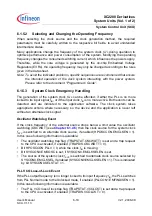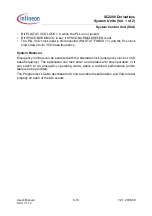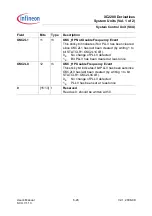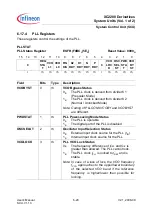
XC2200 Derivatives
System Units (Vol. 1 of 2)
System Control Unit (SCU)
User’s Manual
6-18
V2.1, 2008-08
SCU, V1.13
6.1.5.2
Selecting and Changing the Operating Frequency
When selecting the clock source and the clock generation method, the required
parameters must be carefully written to the respective bit fields, to avoid unintended
intermediate states.
Many applications change the frequency of the system clock
f
SYS
during operation to
optimize performance and power consumption of the system. Modifying the operating
frequency changes the consumed switching current, which influences the power supply.
Therefore, while the core voltage is generated by the on-chip Embedded Voltage
Regulators (EVRs), the operating frequency may only be changed according to the rules
given in the data sheet.
Note: To avoid the indicated problems, specific sequences are recommened that ensure
the intended operation of the clock system interacting with the power system.
Please refer to the document “Programmer’s Guide”.
6.1.5.3
System Clock Emergency Handling
The generation of the system clock
f
SYS
can be affected, if either the PLL is no more
locked to its input signal
f
IN
, or if the input clock
f
IN
is no more active. Both events can be
detected and are indicated to the application software. The clock system takes
appropriate actions where necessary, so the device and the application is never left
without an alternate clock signal.
Oscillator Watchdog Event
If the clock frequency of the external source drops below a limit value the oscillator
watchdog (OSCWDT) (see
) then the clock source for the system clock
f
SYS
is switched to an alternate clock source, if enabled (HPOSCCON.EMCLKEN = 1).
In this case following information is available:
•
The oscillator watchdog trap flag (TRAPSTAT.OSCWDTT) is set and a trap request
to the CPU is activated, if enabled (TRAPDIS.OSCWDTT = 0).
•
Bit HPOSCCON.PLLV = 0, while the clock
f
IN
is missing
•
Bit SYSCON0.EMSOSC is set, if SYSCON0.EMCLKSELEN is set
•
The source of the system clock
f
SYS
is switched to alternate clock source selected by
SYSCON0.EMCLKSEL, if enabled (SYSCON0.EMCLKSELEN = 1). This is indicated
by bit SYSCON0.SELSTAT = 1.
PLL VCO Loss-of-Lock Event
If the PLL output frequency is no longer locked to its input frequency
f
IN
, the PLL switches
from PLL Normal mode to the Unlocked mode, if enabled (PLLCON1.EMFINDISEN = 1).
In this case following information is available:
•
The PLL VCO loss of lock trap flag (TRAPSTAT.VCOLCKT) is set and a trap request
to the CPU is activated, if enabled (TRAPDIS.VCOLCKT = 0).






























